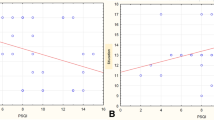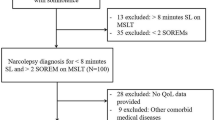Abstract
It is known that quality of life in myasthenia gravis is positively correlated with subjective sleep quality, still no data is available regarding the relationship between QOL and polysomnographically detected sleep parameters and disorders. In this study, we tried to highlighten this relationship, by performing polysomnography. Sleep-related complaints were evaluated in face-to-face interviews with 19 clinically stable MG patients and 26 healthy controls. During the interviews questionnaires assessing sleep quality, excessive daytime sleepiness, fatigue, depression, anxiety, and Turkish version of the MG-QOL 15-item scale [(MG-QOL15(T)] were administered and then an overnight polysomnography was performed. Sleep disorders, especially obstructive sleep apnea and fatigue were higher, whereas subjective sleep duration was significantly lower, in patients than controls. Excessive daytime sleepiness and poor sleep quality were not different between patients and controls. Other than percentage of sleep stage III, which was negatively correlated with MG-QOL15(T) scores, neither other sleep parameters nor sleep disorders were correlated with MG-QOL15(T) scores. MG composite, subjective sleep duration, fatigue severity and Hamilton depression rating scale scores were found to be positively correlated with MG-QOL15(T) scores. It was shown that decreasing disease severity and enhancing psychological well-being will improve patients’ quality of life. We recommend that our findings should be repeated in a large prospective cohort of MG patients.
Similar content being viewed by others
References
Burns TM, Conaway MR, Cutter GR, Sanders DB, Muscle Study Group (2008) Less is more, or almost as much: a 15-item quality-of-life instrument for myasthenia gravis. Muscle Nerve 38:957–963
Paul RH, Nash JM, Cohen RA, Gilchrist JM, Goldstein JM (2001) Quality of life and well-being of patients with myasthenia gravis. Muscle Nerve 24:512–516
Basta IZ, Pekmezović TD, Perić SZ, Kisić-Tepavčević DB, Rakočević-Stojanović VM, Stević ZD, Lavrnić DV (2012) Assessment of health-related quality of life in patients with myasthenia gravis in Belgrade (Serbia). Neurol Sci 33:1375–1381
Burns TM, Graham CD, Rose MR, Simmons Z (2012) Quality of life and measures of quality of life in patients with neuromuscular disorders. Muscle Nerve 46:9–25
Kulkantrakorn K, Sawanyawisuth K, Tiamkao S (2010) Factors correlating quality of life in patients with myasthenia gravis. Neurol Sci 31:571–573
Leonardi M, Raggi A, Antozzi C, Confalonieri P, Maggi L, Cornelio F, Mantegazza R (2010) The relationship between health, disability and quality of life in myasthenia gravis: results from an Italian study. J Neurol 257:98–102
Masuda M, Utsugisawa K, Suzuki S, Nagane Y, Kabasawa C, Suzuki Y, Shimizu Y, Utsumi H, Fujihara K, Uchiyama S, Suzuki N (2012) The MG-QOL15 Japanese version: validation and associations with clinical factors. Muscle Nerve 46:166–173
Prudlo J, Koening J, Ermert S, Juhász J (2007) Sleep disordered breathing in medically stabile patients with myasthenia gravis. Eur J Neurol 14:321–326
Sieminski M, Bilińska M, Nyka WM (2012) Increased frequency of restless legs syndrome in myasthenia gravis. Eur Neurol 68(3):166–170
Reimer MA, Flemons WW (2003) Quality of life in sleep disorders. Sleep Med Rev 7:335–349
Moyer CA, Sonnad SS, Garetz SL, Helman JI, Chervin RD (2001) Quality of life in obstructive sleep apnea: a systematic review of the literatüre. Sleep Med 2:477–491
Martinez-Lapiscina EH, Erro ME, Ayuso T, Jericó I (2012) Myasthenia gravis: sleep quality, quality of life, and disease severity. Muscle Nerve 46:174–180
Burns TM, Conaway M, Sanders DB, MG Composite and MG-QOL15 Study Group (2010) The MG composite: a valid and reliable outcome measure for myasthenia gravis. Neurology 74:1434–1440
Barohn RJ (2003) Standards of measurements in myasthenia gravis. Ann N Y Acad Sci 998:432–439
Johns MW (1991) A new method for measuring daytime sleepiness: the Epworth sleepiness scale. Sleep 14:540–545
Agargun MY, Kara H, Anlar O (1996) The validity and reliability of the Pittsburgh Sleep Quality Index. Turk Psikiyatri Derg 7:107–111 (Turkish with an English abstract)
Krupp LB, LaRocca NG, Muir-Nash J, Steinberg AD (1989) The fatigue severity scale. Application to patients with multiple sclerosis and systemic lupus erythematosus. Arch Neurol 46:1121–1123
Tascilar NF, Saracli O, Kurcer MA, Ankarali H, Emre U (2016) Reliability and validity of the Turkish version of Myasthenia Gravis-quality of life questionnaire-15 item. Turk J Med Sci 46(4):1107–1113
Allen RP, Picchietti D, Hening WA, Trenkwalder C, Walters AS, Montplaisi J, Restless Legs Syndrome Diagnosis and Epidemiology workshop at the National Institutes of Health; International Restless Legs Syndrome Study Group (2003) Restless legs syndrome: diagnostic criteria, special considerations, and epidemiology. A report from the restless legs syndrome diagnosis and epidemiology workshop at the National Institutes of Health. Sleep Med 4:101–119
AASM (American Academy of Sleep Medicine) (2005) ICSD-2-International classification of sleep disorders, 2nd edn: diagnostic and coding manual. American Academy of Sleep Medicine, Westchester, IL
Coleman RM (1982) Periodic movements in sleep (nocturnal myoclonus) and restless legs syndrome. In: Guileminault C (ed) Sleeping and walking disorders. Addison-Wesley, Menlo Park, CA, pp 265–295
Iber C, Ancoli-Israel S, Chesson A, Quan SF, For the American Academy of Sleep Medicine (2007) The AASM manual for the scoring of sleep and associated events: rules, terminology and technical specifications, 1st edn. American Academy of Sleep Medicine, Westchester, IL
First MB, Spitzer RL, Gibbon M, Williams JBM (1997) Structured clinical interview for DSM-IV axis I disorders: clinical version (SCID-CV). American Psychiatric Press, Washington, DC
Yazici MK, Demir B, Tanriverdi N, Karaagaoglu E, Yolac P (1998) Hamilton anxiety rating scale: interrater reliability and validity study. Turk Psikiyatri Derg 9:114–117
Akdemir A, Türkçapar MH, Orsel SD, Demirergi N, Dag I, Ozbay MH (2001) Reliability and validity of the Turkish version of the Hamilton depression rating scale. Compr Psychiatry 42:161–165
Franzen PL, Buysee DJ (2009) Sleep in psychiatric disorders. In: Chokroverty S (ed) Sleep disorders medicine: basic science, technical considerations and clinical aspects, 3rd edn. Saunders Elsevier, Philadelphia, PA, pp 538–550
Jones SM, Gwathmey KG, Burns TM (2015) Quality of life measures for myasthenia gravis and evaluation of non-motor symptoms. Clin Exp Neuroimmunol 6(1):32–39
Twork S, Wiesmeth S, Klewer J, Pöhlau D, Kugler J (2010) Quality of life and life circumstances in German myasthenia gravis patients. Health Qual Life Outcomes 8:129. doi:10.1186/1477-7525-8-129
Raggi A, Leonardi M, Antozzi C, Confalonieri P, Maggi L, Cornelio F, Mantegazza R (2010) Concordance between severity of disease, disability and health-related quality of life in myasthenia gravis. Neurol Sci 31:41–45
Mourão AM, Araújo CM, Barbosa LS, Gomez RS, Burns TM, Lemos SM, Teixeira AL (2013) Brazilian cross-cultural translation and adaptation of the “Questionnaire of Life Quality Specific for Myasthenia Gravis—15 items”. Arq Neuropsiquiatr 71:955–958
Padua L, Evoli A, Aprile I, Caliandro P, D’Amico P, Rabini A, Tonali P (2002) Quality of life in patients with myasthenia gravis. Muscle Nerve 25:466–467
Rostedt A, Padua L, Stålberg EV (2006) Correlation between regional myasthenic weakness and mental aspects of quality of life. Eur J Neurol 13:191–193
Happe S, Klösch G, Zeitlhofer J (2004) Perception of dreams and subjective sleep quality in patients with myasthenia gravis. Neuropsychobiology 50:21–27
Choueiry N, Salamoun T, Jabbour H, El Osta N, Hajj A, Rabbaa Khabbaz L (2016) Insomnia and relationship with anxiety in university students: a cross-sectional designed study. PLoS One 11(2):e0149643. doi:10.1371/journal.pone.0149643 (eCollection 2016)
Rocha PM, Neves FS, Corrêa H (2013) Significant sleep disturbances in euthymic bipolar patients. Compr Psychiatry 54(7):1003–1008
Riemann D, Berger M, Voderholzer U (2001) Sleep and depression-results from psychobiological studies: an overview. Biol Psychol 57(1–3):67–103
Fernandez-Mendoza J, Calhoun SL, Bixler EO, Karataraki M, Liao D, Vela-Bueno A, Jose Ramos-Platon M, Sauder KA, Basta M, Vgontzas AN (2011) Sleep misperception and chronic insomnia in the general population: role of objective sleep duration and psychological profiles. Psychosom Med 73(1):88–97
Bianchi MT, Williams KL, McKinney S, Ellenbogen JM (2013) The subjective-objective mismatch in sleep perception among those with insomnia and sleep apnea. J Sleep Res 22(5):557–568
Parrino L, Milioli G, De Paolis F, Grassi A, Terzano MG (2009) Paradoxical insomnia: the role of CAP and arousals in sleep misperception. Sleep Med 10(10):1139–1145
Fermin AM, Afzal U, Culebras A (2016) Sleep in neuromuscular diseases. Sleep Med Clin 11(1):53–64
Soreq H (1998) Cholinergic mechanisms–tenth international symposium. IDrugs 1(7):787–793 (abstract)
Paul RH, Cohen RA, Goldstein JM, Gilchrist JM (2000) Fatigue and its impact on patients with Myasthenia Gravis. Muscle Nerve 23(9):1402–1406
Elsais A, Wyller VB, Loge JH, Kerty E (2013) Fatigue in myasthenia gravis: is it more than muscular weakness? BMC Neurol 13:132. doi:10.1186/1471-2377-13-132
Kittiwatanapaisan W, Gauthier DK, Williams AM, Oh SJ (2003) Fatigue in myasthenia gravis patients. J Neurosci Nurs 35(2):87–106
Fernandes Oliveira E, Nacif SR, Alves Pereira N, Fonseca NT, Urbano JJ, Perez EA, Cavalcante V, Santos Oliveira C, Insalaco G, Oliveira AS, Oliveira LV (2015) Sleep disorders in patients with myasthenia gravis: a systematic review. J Phys Ther Sci 27(6):2013–2018
Kulaksizoglu IB (2007) Mood and anxiety disorders in patients with myasthenia gravis: aetiology, diagnosis and treatment. CNS Drugs 21:473–481
Paiva T, Attarian H (2014) Obstructive sleep apnea and other sleep-related syndromes. Handb Clin Neurol 119:251–271
Bjornsdottir E, Keenan BT, Eysteinsdottir B, Arnardottir ES, Janson C, Gislason T, Sigurdsson JF, Kuna ST, Pack AI, Benediktsdottir B (2015) Quality of life among untreated sleep apnea patients compared with the general population and changes after treatment with positive airway pressure. J Sleep Res 24(3):328–338
Tomfohr LM, Ancoli-Israel S, Loredo JS, Dimsdale JE (2011) Effects of continuous positive airway pressure on fatigue and sleepiness in patients with obstructive sleep apnea: data from a randomized controlled trial. Sleep 34(1):121–126
Author information
Authors and Affiliations
Corresponding author
Ethics declarations
Conflict of interest
The author(s) declare that they have no competing interests.
Ethical approval
This study was approved by the ethical committee of Bulent Ecevit University Clinical (No. 2012/03-15) and Istanbul Medipol University (No. 2015/03-136) non-interventional clinical research review boards, and it was in accordance with the 1964 Helsinki declaration and its later amendments or comparable ethical standards.
Informed consent
Patients were given informed consent to participate in this study. They accepted to fill the questionnaires and to have a polysomnography.
Electronic supplementary material
Below is the link to the electronic supplementary material.
13760_2017_787_MOESM2_ESM.docx
Online resource 2 Sleep architecture parameters in polysomnography in patients and controls after adjusting to HAM-D and HAM-A by covariate analyses (HAM-D and HAM-A were used as covariates) (DOCX 17 kb)
Rights and permissions
About this article
Cite this article
Tascilar, N.F., Saracli, O., Kurcer, M.A. et al. Is there any relationship between quality of life and polysomnographically detected sleep parameters/disorders in stable myasthenia gravis?. Acta Neurol Belg 118, 29–37 (2018). https://doi.org/10.1007/s13760-017-0787-6
Received:
Accepted:
Published:
Issue Date:
DOI: https://doi.org/10.1007/s13760-017-0787-6




